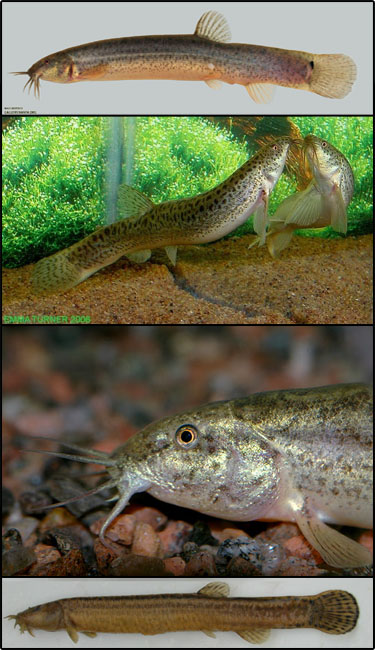Weather loach (Misgurnus anguillicaudatus)
 Description: Established populations found in the United States starting in the 1800s; spread to more than 15 states since then including Michigan, Indiana and Illinois. Introduction likely from escapes or releases from aquariums, fish farms, or bait buckets.
Description: Established populations found in the United States starting in the 1800s; spread to more than 15 states since then including Michigan, Indiana and Illinois. Introduction likely from escapes or releases from aquariums, fish farms, or bait buckets.Identification: Light olive or tan sides with dusky blotches, usually dark spots on dorsal and caudal fins; usually small black spot at upper edge of caudal fin base. Long, cylindrical, eel-like body with small mouth and barbels. Rounded caudal fin, dorsal fin above pelvic fin origin, stout spine on pectoral fin. Nine dorsal rays, six to seven pelvic rays and seven to eight anal rays. Adults up to 11 inches but 6 inches is more common.
Habitat: Native to eastern Asia. Prefers mud-bottomed, shallow pools and backwaters. Can survive in poorly oxygenated water.
Reproduction: Weather loaches reproduce externally - A male wraps his body around the female to stimulate the release of eggs, which he then fertilizes. The eggs scatter through the open water and over substrate. No parental care is given.
Impact and Damage: Weather loaches have the ability to reduce populations of aquatic insects that native fish rely on for food and can therefore reduce their populations as well.
Monitoring and rapid response: Public awareness and education are being used in some areas to reduce the spread of the species and to increase the public's ability to identify the species and report new sightings. Credits: The information contained in this factsheet was provided by the Shedd Aquarium.
Photos (T-B) courtesy of The North American Native Fishes Association (NANFA), Emma Turner, AKVA Forum - Norway, and Pamela Woods.
Common Name: | Weather loach |
Scientific Name: | Misgurnus anguillicaudatus |
Family: | Cobitidae (Loach) |
Habit: | Fish |
 View Species Course |
|
